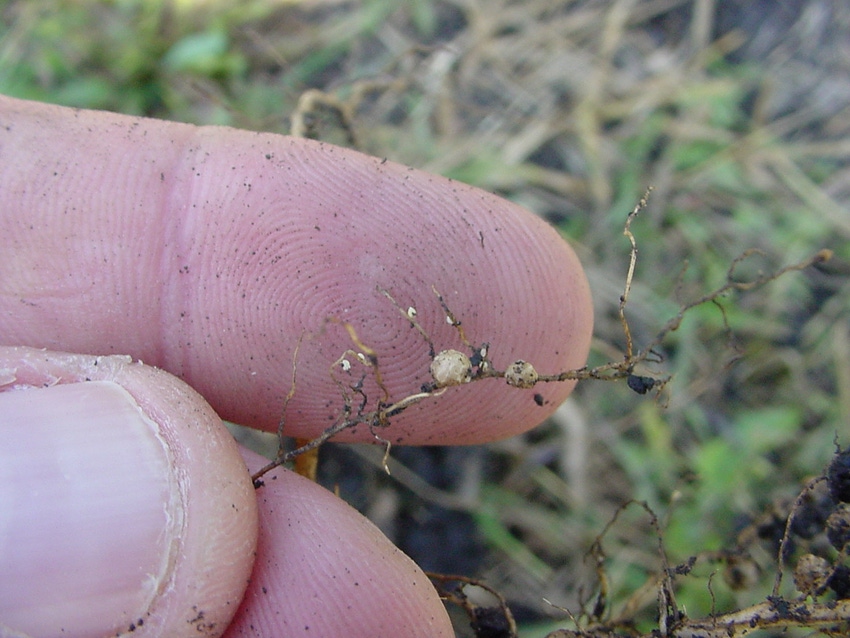
It’s no secret to producers how nematodes are able to change and do it constantly.
In response to the changes nematodes are doing regularly, the North Central Soybean Research Program and the United Soybean Board are now working together on a national soybean nematode strategic plan.
“Nematodes are incredibly complex foes, and we need to find new solutions for soybean growers and protect current management tools,” says Melissa Mitchum, University of Missouri nematologist and one of the strategic plan’s authors.
Mitchum cites soybean cyst nematode (SCN) as an example of why farmers need new solutions. “We’ve managed SCN for 20-plus years using basically one tool: SCN-resistant varieties. Unfortunately, 95 percent of SCN-resistant varieties have the same genetic source of resistance from PI 88788,” she explains. “In effect, over two decades we’ve selected more aggressive SCN populations that can overcome our main management tool. But farmers may not be aware of this.”
Soy checkoff organizations are working with public universities and agricultural companies to coordinate and support complementary projects to develop short- and long-term solutions for parasitic nematode control.
The plan includes research, education and outreach efforts with the end goal being that farmers get the most profitability possible even with the increase threat of nematodes.
The six goals include:
1: Develop Nematode Genomic and Genetic Tools, Resources and Data (Nematode focus)
This will mean a focus on genetic tools, genomic resources and the data that can be collected. The idea is to help identify the weaknesses of nematodes and develop a plan to deal with them.
2: Discover, Leverage and Enhance Native Nematode Resistance in Soybean (Soybean focus)
The plan is to improve existing SCN resistance sources.
Plus, identify and evaluate new sources of genetic resistance and breed them into high-yielding backgrounds in all maturity groups for targeted management options. Also to develop multi-nematode- (such as root-knot and reniform) resistant germplasm for farmers in the Southern US.
3: Engineer Resistance Using Molecular Tools to Generate or Improve Nematode Resistance (Transgenic focus)
The goal is to advance transgenic and gene editing technologies and tools for more efficiency and effective engineered resistance. Plus, develop new transgenic sources of nematode resistance for farmers.
4: Assess the Impacts of New Management Practices on Nematode Population Dynamics (Management focus)
The idea is to get the most out of various agronomic practices to fight SCN. This includes rotating non-host crops, different sources of resistance, the effects of cover crops and the management of other soybean diseases.
The goal is to identify soil, root and rhizosphere microbes that naturaly control nematodes.
5: Conduct Nematode Surveys for Improved Diagnostics and Economic Impact (Information focus)
A standard for sampling nad processing soil samples for the most accurate results must be made. Farmers must have the ability to get the best seed with the best resistance for their fields.
Plus, provide farmers with population type data and variety recommendations quickly.
6: Foster Extension, Education and Outreach (Audience focus)
This goal is intended to increase awareness and a sense of urgency among farmers for nematode threats and management recommendations in the short and long term. Plus, customize nematode management recommendations for farmers and advisors in different geographic regions. Also, a plan to standardize germplasm and variety labeling for farmers and advisors is part of the goal.
Solutions to SCN
The situation with SCN shows why the plan has short-term and long-term projects.
The SCN Coalition is asking farmers to test their fields so they know their nematode numbers, rotate resistant varieties, rotate to non-host crops and consider nematode-protectant seed treatments.
Longer term, checkoff-funded researchers are working to develop new solutions and an integrated, multipronged approach to managing SCN. “Researchers are looking at new native and biotech traits, new chemistries, new biologicals, new management practices and rotation strategies,” she adds.
Scientists notch several successes
One example of a research success in the field of soybean genetics: Researchers have determined the identity of the most important SCN resistance genes in soybean, Rhg1 and Rhg4; discovered that these genes are repeated throughout the plant’s genetics; and shown that the number of copies of these genes matters. The higher the copy number, the higher the resistance levels.
“That’s why some SCN-resistant varieties with PI 88788 resistance are more effective than others,” Mitchum explains. “Some have higher copy numbers of those genes.”
Another success story involves discovering new sources of native (non-GMO) resistance and stacking them with existing sources of SCN resistance. Checkoff-funded researchers recently created a four-gene stack using two recently discovered resistance genes from wild soybean (Glycine soja), a resistance gene from PI 567516C and Rhg1 from PI 88788. This stack has been bred into high-yielding backgrounds and released to the industry.
Scientists have also generated high-quality reference genomes for SCN and root-knot nematode that serve as good “genetic roadmaps.” These allow researchers to look for nematode vulnerabilities to chemical and bioengineered control and develop new management tools for farmers.
For example, using the recently published SCN Reference Genome, researchers have identified hundreds of candidate parasitism genes in SCN. They are currently working to identify how those genes function.
“The long-term goal is to inhibit those genes in the nematode, stack that technology with natural resistance and provide farmers with a novel mode of action,” Mitchum says. “We want to use as many different modes of action as possible to keep nematodes from evolving to overcome our tools.”
About the Author(s)
You May Also Like




